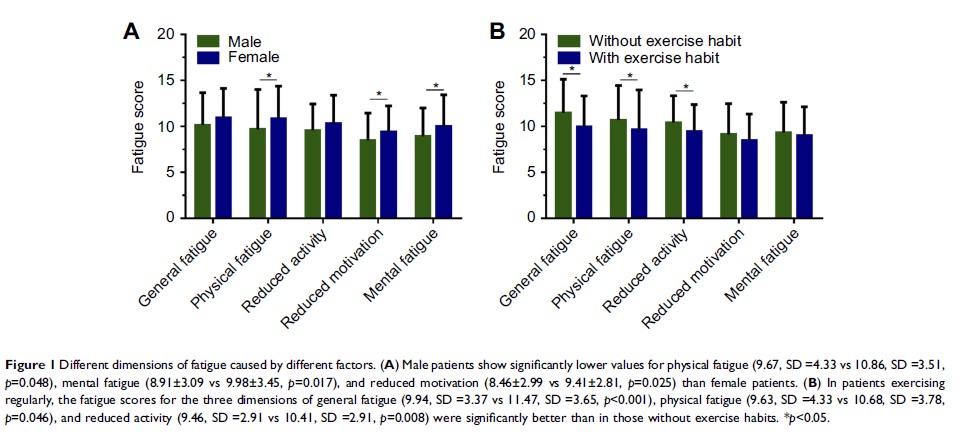9 1 2 3 6
论文已发表
注册即可获取德孚的最新动态
IF 收录期刊
- 2.6 Breast Cancer (Dove Med Press)
- 3.9 Clin Epidemiol
- 3.3 Cancer Manag Res
- 3.9 Infect Drug Resist
- 3.6 Clin Interv Aging
- 4.8 Drug Des Dev Ther
- 2.8 Int J Chronic Obstr
- 8.0 Int J Nanomed
- 2.3 Int J Women's Health
- 3.2 Neuropsych Dis Treat
- 4.0 OncoTargets Ther
- 2.2 Patient Prefer Adher
- 2.8 Ther Clin Risk Manag
- 2.7 J Pain Res
- 3.3 Diabet Metab Synd Ob
- 4.3 Psychol Res Behav Ma
- 3.4 Nat Sci Sleep
- 1.9 Pharmgenomics Pers Med
- 3.5 Risk Manag Healthc Policy
- 4.5 J Inflamm Res
- 2.3 Int J Gen Med
- 4.1 J Hepatocell Carcinoma
- 3.2 J Asthma Allergy
- 2.3 Clin Cosmet Investig Dermatol
- 3.3 J Multidiscip Healthc

与慢性乙型肝炎患者疲劳相关的危险因素
Authors Zhong C, Yin J, Zheng Z, Cai S, Gao Y
Received 27 February 2019
Accepted for publication 6 June 2019
Published 4 July 2019 Volume 2019:13 Pages 1065—1072
DOI https://doi.org/10.2147/PPA.S206953
Checked for plagiarism Yes
Review by Single-blind
Peer reviewers approved by Dr Cristina Weinberg
Peer reviewer comments 2
Editor who approved publication: Dr Naifeng Liu
Aim: To evaluate fatigue in chronic hepatitis B patients and its related independent factors, as well as the relationship between fatigue and health-related quality of life (HRQoL).
Materials and methods: The study enrolled 400 patients who met the selection criteria, and their sociodemographic information was collected. The 36-item Short-Form Health Survey (SF-36) and Multidimensional fatigue inventory 20 (MFI-20) were adopted to evaluate HRQoL and fatigue level.
Results: Significant differences between the fatigue group and non-fatigue group were observed for the female proportion (p =0.021), height (p =0.003), and weight (p =0.010), with or without regular exercise (p =0.001). We further determined the dimensions of fatigue that were affected by these factors and found that male patients showed significantly lower results than female patients in terms of physical fatigue (p =0.048), mental fatigue (p =0.017), and reduced motivation (p =0.025). In patients who exercised regularly, the fatigue scores for the three dimensions of general fatigue (p <0.001), physical fatigue (p =0.046), and reduced activity (p =0.008) were significantly better than in those without exercise habits. Multivariate analysis was conducted, which suggested that only height and regular exercise habits were the independent factors affecting the patients’ fatigue levels. We further analyzed the relationship between quality of life and fatigue. With respect to physiological HRQoL, the average fatigue score of patients with high HRQoL was 41.91, which was significantly lower than that of patients with low physiological HRQoL (56.18, p <0.001). Moreover, the average fatigue score in patients with low psychological HRQoL was 55.25, which was significantly higher than that of patients with high psychological HRQoL (41.23, p <0.001). Correlation analysis showed that the physiological HRQoL and psychological HRQoL scores were negatively correlated with fatigue score (r = −0.639, p <0.001 and r = −0.655, p <0.001, respectively).
Conclusions: In this study, we found that the fatigue dimensions of chronic hepatitis B patients differed between various subpopulations. Height and regular exercise habits were the independent factors that affected the patients’ fatigue levels. Moreover, HRQoL was correlated with fatigue level. For patients with risk factors of fatigue, target intervention is advised in order to decrease fatigue and increase HRQoL.
Keywords: chronic hepatitis B, health-related quality of life, fatigue, mental disorder, risk factor
